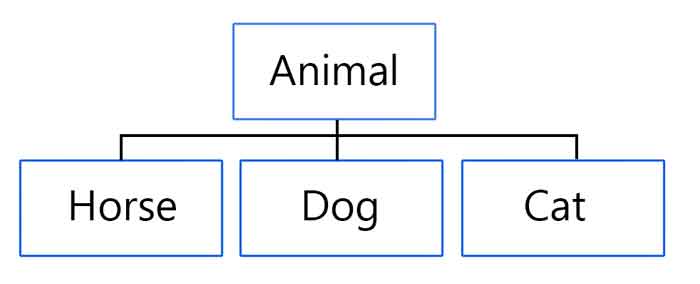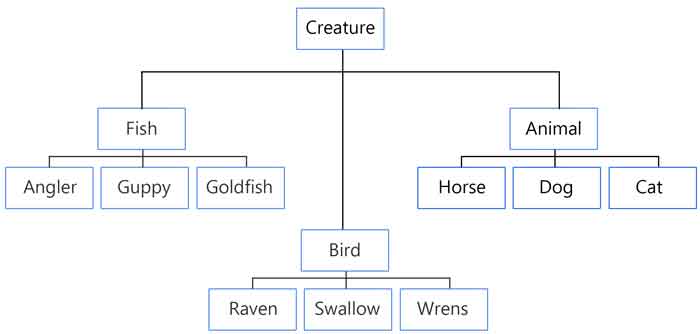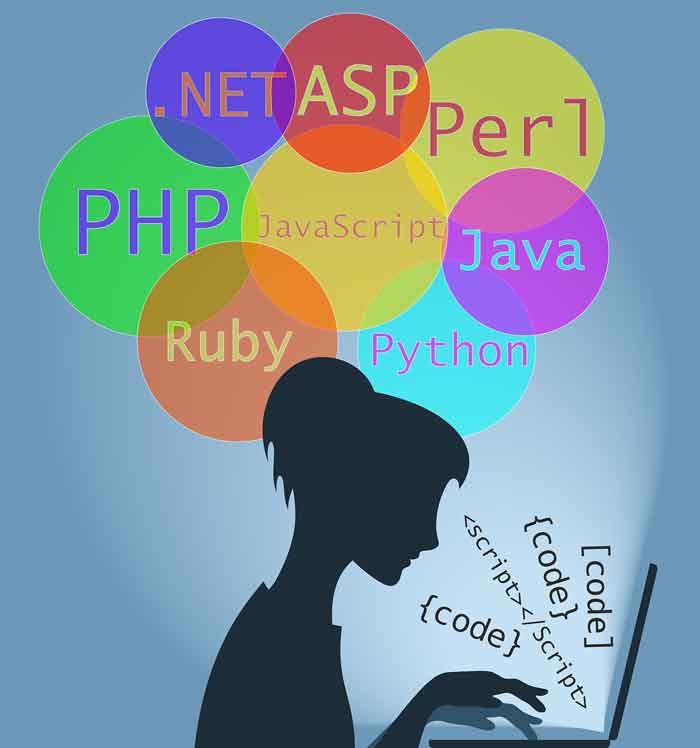Let’s Take A Tour Around The 3 Widely Used Programming Languages, And To Compare Them In Details
Python, Java & C# are among the most used programming languages in the world. Python is very popular among new programmers, and it competes head-to-head with Java & JavaScript over which one is the most popular. C# is widely used in Microsoft solutions, and it also has its place in games development. It can be easier to learn Python first, but there are also some advantages of learning any of the other two languages. In this article, I will take you into a tour between these languages, whether you are pondering on which one to learn first, or if you want to know which one is the best for a certain cases.
Quickly go to:-
- About This Comparison
- Performance
- Scalability
- Strongly-Typed VS Weakly-Typed
- External Libraries
- Backward-Compatibility
- Which Language Is Easier To Learn?
- Picking A Programming Language Based On The Type Of Application You Want To Develop
- Cross-Platform Development
- Learn More Than One
- Why Is Python Popular?
- And Finally
- Sources & Useful Links
- See Also:-
About This Comparison
I will compare the 3 programming languages in many aspects, like performance, common applications for each language, scalability, performance, backward compatibility and more importantly, how easy to learn the languages, and many more. Some of these languages is better than others in certain aspects, and sometimes you could still use the worse language and get around its limitation, while in some other times it’s better to go for another language. There are times where a language outside this comparison is better for the job, like in case of game development. I totally wanted to add more languages to this comparison, but that will make this post way too long.
No, let’s get started~
Performance

C# & Java are compiled into a Bytecode, which is produced by the compiler. The Bytecode is compiled into a machine code at runtime with the Just-In-Time interpreter, also known as JIT.
The JIT nature is different by the language, but it usually optimizes the parts of the code that runs often, which increases the performance. As a general rule, JIT languages tend to be faster than Interpreted languages.
Java tends to have a slower start-up speed. That makes is not that great to create simple programs to run from command line.
Python is an interpreted language. The interpreter directly executes each line of code at runtime, one after the other. That means that a code can run for some time, then stops running the moment it finds an error. You could fix the error then continue running the program, which is one of its good sides, but that also means some errors can only be discovered at runtime. In Python, type checking happens at run time, and that tends to affect performance. It’s not uncommon for Python program to take X 2 or more the time to execute the same program as many other languages.
Python keeps being optimized regularly, and just like we used to think that Java & C# aren’t a good replacement for C++ in a lot of cases, there may come a time where we could code in Python with a minimal difference in performance.
Scalability
When it comes to software development, scalability has multiple meanings. If an application is scalable, then it can be expanded to serve more & more people. That depends on how you build the software, as well as the framework your picked up for that. The programming language itself doesn’t fully determine that. My focus on this section will be the ease of maintaining large projects, which contain a large amount of code lines, since that’s the one aspect of scalability that can be affected by your choice of a programming language.
In strong-typed languages, like Java & C#, it’s often easier to make modification to a larger code. If you changed a variable type from int to double, the IDE you’re using, be it Eclipse or Visual Studio, will mark all the errors caused by this change, so you could make the necessary modifications. They even give you the ability to refractor your code & make these changes with a push of a button.
On the other hand, type-checking in Python happens at runtime, so this type of errors could only appear during testing, which means rigorous testing is needed to discover all mistakes. This can be done with the right discipline, but it’s an unwanted overhead. This is one of the most used arguments against Python, and it could make your life a living hell. Because of that, writing unit tests is more important in Python compared to the other languages. Optional type-checkers like mypy were created to make life easier for Python programmers.
All that is not be an issue at all for a small project, where Python allows you to create an small application much faster, but it gets harder & harder as the project grows. You may be thinking:- “That doesn’t matter, I will only be using my language to write small applications”. You shouldn’t say that. Many large applications start small, then get much bigger over time, that goes to both personal & professional projects. Also, if you are writing small applications today, you may end up writing bigger applications years later, you never know.
Scalability is a huge topic in general, and deserves a book on its own, not just an article.
Strongly-Typed VS Weakly-Typed
Java & C# are strong-typed languages. When you define a variable (see the definition below) in those languages. You will need to explicitly define its type.
What’s is variable?:- variable is a value with a name. If you are writing a program that takes two numbers from the user and adds them, you will need to declare place in memory with a name to store them, and that’s what a variable is. A variable can be a number, string/text, boolean and of many other types.
Once you define the variable in these languages, you will have to abide by its type when you use it in your code later on.
This is how you declare variables in C# & Java, notice how the type is specified before each variable name:-
int Number = 12; String Message = "This is a string message!"; bool TrueOrFalse = true; float NotDecimal = 1.1112;
In strong-typed language, if you defined a string, and let’s say its value is “123”, you won’t be able to use it in your calculations, even if it seems to contain a number, unless you explicitly converted it to a number, in which case, you will only be able to assign it to a number variable (like int, float, double…. etc). The following Java/C# code won’t even compile, since you declared value as an integer, then you tried to assign a string to it:-
int Value = 5; Value = "Hihi~";
You can’t change the variable type by declaring it again, it will be considered a duplicate variable:-
int Value = 5; String Value = "Hihi~";
On the other hand, Python is dynamic-typed language. So you could declare a variable, assign a number to it, then assign a string value to it at some other time without any issue.
The following Python code will work perfectly:-
Value = 5 # Value will be treated as an integer/number from here on Value = 'Hihi~' # Value is a string now
Dynamic typing is easier on the programmer, since you don’t have to care what type of variable you are using, which frees your mind and helps you focus on coding your program. It requires less typing (although programmers spend way more time debugging, so this doesn’t matter as much as you think). To new programmers, it seems like a hassle to declare the variable type each time you declare one.
That being said, this doesn’t mean strong-types are a waste of time. It makes it much easier to detect errors, usually before you even compile & run your application. It also helps the Just-In-Time compiler (JIT) to optimize the code, which helps your program run faster. As I mentioned earlier, since the compiler could detect these error, editing a large code could be easier, since you could make a change to a type of a variable, and then the compiler will tell you where to change your code to go with the change. Let’s not forget that you could do that with a push of a button too.
On the other hand, dynamic typing means error can only be caught during runtime, which requires you to do more testing to catch all of them, and that’s a cost your should be aware of. You will have to make sure you run each line of code at least once during testing. Because the variable type is determined each time it gets read or written, that affects performance in a way.
It may seem like you can’t do many things with the restrictions of strong-typed languages, while there are some tricks you could do with Python that are not possible with these languages, there’s no solution you can’t code in those language that’s only possible in Python. Having to declare a variable with each variable could be annoying for new programmers, but it’s a habit you can get into over time.
Both types of languages has its own pros and cons. Python is very a dynamic language in general, not just with variables, you could change a whole function definition during runtime, it also allows you to define an array of totally different types. This can be too convenient for the developer, which makes it faster to develop solutions quickly with it. Having even more ways to do the same thing makes things easier in general.
External Libraries
All the languages in this comparison has all sorts of libraries. From machine-learning to API libraries for different services. Enough to get keep you busy for a while.
Since I am not trying to encourage you to learn one language while leaving all the others on the table, I don’t think having certain libraries in one language but not the others is an issue. No matter what language you choose, you will find few libraries for all the common uses. If your needs changed, and so you needed to learn another language for that, you should go for it. It’s the common way of thinking among software developers to consider programming languages as a tool, not as a religion you can’t convert from.
Backward-Compatibility
Java virtual machine can virtually run any application that was written & compiled on previous versions. I say virtually because there are cases where the application may not work correctly, since it could be using a deprecated code or something. A code written in Java 11 can run on 10, as long as you didn’t use any of Java 9 features.
Python has one issue with compatibility, as Python 2.0 is quite different from Python 3.0, which caused a big rift between the codebases & developers of the two.
Take the following code for example:-
print "Hihi~" # works with Python 2 only
print("Hihi~") # works with Python 2 and 3
Unless you have specific requirements or needs that makes you want to use Python 2, you should learn Python 3 right off the bat. Python 2 is considered a legacy programming language. Despite that, many applications are still using Python 2.7, because some libraries were not ported to it, this is getting better over time, but you may run into a some situation where you have to learn & use Python 2. Other than that, Python 3 is the way to go, it makes many things easier, like how it offers multilanguages support, for one.
C#, and .NET framework, are generally backward-compatible. Just like the case with the other languages, you won’t be able to compile a code written on a new version on an older one. However, an application written & compiled on an older version of .NET framework will virtually work on the newer version of the framework, and just like the case with Java, this is virtually true, and some issues may occur if the compiled version is too old.
Which Language Is Easier To Learn?
This is a question one new to programming tend to ask often. The answer is easy:- Python is the easiest language to learn in this comparison. It makes it much easier to learn software development, since it’s much less strict, and your focus will be on learning how to write algorithms, which is what programming is about. If you learned Python, then it will be much easier to learn Java, C#, or any programming language later on.
It goes the other way around too, Java & C# has their own advantages. It’s much easier to get into Object-Oriented Programming with them, which is a very common concept in programming languages today.
Object-Oriented Programming is a programming paradigm based on objects, each part of your program is an object of some kind.
For example, say you have a game with multiple animals. Like a cat, dog & horse. in Object-Oriented-Programming, you could define an Animal class, and then a class for each animal kind, like this:-

What’s the point for this? Well, this allows you to define all sorts of common behavior in the Animal class. All the animals in our example are four-legged & have tails, and can run & eat food. So you only have to do the work for the common behavior in the animal class. In each individual class, you could define only the difference between the animals. You could make cats mew, dogs bark & horses neigh.
It may not seems like we have saved yourself a lot of time. But the bigger the hierarchy gets, the better organizing things will work. We could expand this diagram to include more creatures:-

With that done, you could have multiple Animal or creature objects (in an array maybe), and without knowing which animal is which, you could call the Cry function, and then hear different sounds, and without doing any checking at all.
One great benefit from Object-Oriented Programming is separating different responsibilities into different parts, which makes the application modular. That way, so you could reuse each parts in another applications you write later, this is known as code reusing. It also makes it much easier to expand your existing applications by adding more objects (like adding more animals, in the example above). If your application is modular, you could replace each part with another, if the data object in your application connects to an Oracle database, you could replace it with one that connects to a MySQL database by just creating a new type of objects. You could alternate between the two objects, as needed, and store data in multiple types of databases. There are many other advantages of Object-Oriented Programming, but it’s beyond the scope of this article.
As I said, once you learn Python and one of the two programming languages here, it will much easier way with most of the other languages. The first programming language you learn is harder because you’re not only learning the language, but many new concepts as well, like types, loops, if-statements, debugging the code & fixing mistakes, expressions, as well as using the compiler or interpreter & writing algorithms in general.
For that reason, once you learn and become good at coding in one language, you will be able to learn another much faster, because you only need to learn the new concepts related to the new language itself. The same concept applies to learning the 3rd language, where you will have to learn even less concepts, if any. The 5th language is likely a breeze. Unless you learned totally new type of languages, like functional programming language, things will always be easy. If you got to learn a language with a weird syntax, you will have to get used to that syntax, and that’s it. When I got to code with Swift, it wasn’t hard, but I had give myself some time to used to the weird syntax of its functions. Things got easier once you keep coding in the new language.
The first language is a stepping stone to get into software development world, and starting with an easy language is a valid choice here, but you shouldn’t stop there, as you shouldn’t limit yourself to one language if becoming a good software developer is an important goal for you.
If you learned python first, you may find Java or C# a bit stiff to write, but you can get used to it. You may even end up liking it if you started to see the benefits of strong-typed languages (which is one of the reasons people don’t like these languages).
Picking A Programming Language Based On The Type Of Application You Want To Develop
You could pick the language to learn based on what you plan to create with it. As I mentioned earlier in this article, the common attitude among software developer is to treat programming languages as a tool, and to use the most suitable one for the task (sometimes more than one language could work). Many applications has certain languages to code with.
I will try to give you an idea about what’s the most suitable language(s) for each application, although in the intricate world of software development, there are all sorts of options. So do some addition research to know all your options (which are many).
Games Development

For gaming developing, C# is the best among these 3, since it’s used in the Unity engine. Java & python are not exactly better suited for developing games, but they have multiple frameworks for that.
From a technical standpoint, Java doesn’t lack it when it comes to creating games, but it’s not widely used for that. There are many reasons for that:-
-
- No major gaming engine fully supported it. C# is supported in Unity, but Java is not.
- Game developers invested heavily in C & C++, which created a network effect. Gaming development was always tied to Microsoft’s world too.
- Java’s performance isn’t that bad for creating games. Many people accuse garbage collection for causing severe frame drop every time it run. That could happen, but if you coded your game correctly, you could totally avoid huge garbage collecting that could cause that.
- Game consoles, like Xbox & Playstation don’t have Java Virtual Machine (JVM), so porting games written by Java isn’t that easy.
It’s worth noting that Java is the main language for developing Android applications, including games. So it’s not a hopeless language for developing games.
Java can still be used for gaming development, but it’s not a main choice for that, here are a list of Java games development frameworks:-
-
- lwjgl
- libgdx
- jmonkeyengine
- slick2d
From technical perspective, Java doesn’t lack it, and it’s not really that different from C#, the main language I recommended for the task between the language of this comparison.
Python can also be used for developing games, either using PyGame or some other tool, especially if you plan to learn it as a first language. But you may want to learn some other language for that at a later time. It’s worth noting that Python can be used to develop visual novels using the known Ren’Py engine.
C++ may be outside this comparison, but it’s worth mentioning as a very good choice for gaming development. Specially if performance matters. It’s a great choice for creating game engines, and will benefit you if you plan to work in a gaming studio.
You can read my more detailed article about this topic here:- Why Java isn’t a widely used language for games development?
Mobile Development

Java is the official language for Android development, typically using Android Studio, and the way to go to write & run Android apps natively. That includes games development (didn’t I say there are many options for everything?). Java is the only language in this comparison that could be used to develop mobile apps natively & the official way.
Swift is the way to go for developing native iOS apps, as well as Objective-C (although I only recommend you to learn the latter if you plan to work in a company that requires you to use it).
You could use C# to develop for cross-platform mobile apps using Xamarin, that includes both Android & iOS. This is not a native way of building the applications, but it works, and it can save you some development time.
Python could be used for mobile development, but I mostly see it used to develop the backend of the app for both Android & iOS (the server side that receives the app’s request), KivY is a known python mobile application framework.
Artificial Intelligence & Machine Learning

This is a huge field on its own, and the answer depends on what you want to do, and what language offers the libraries that makes your life easier. Assuming you just want to get into AI for now, then Python is the most common choice. It has mature libraries & frameworks for that. Like PyTorch & TensorFlow. It’s the language used in the world of science for these stuff. Including scientists who are not exactly developers (because Python is easy to learn). Some of the heavy-lifting of AI is done in C++ inside the libraries, but you only need to know Python to use it. So performance isn’t exactly an issue here.
That doesn’t mean that Java or C# can’t be used for AI, they are fast languages, and there are many libraries that allows you to do all sorts of things with them. In case of Java, there’s Weka, which is a data mining & machine learning benchmark. Java is popular language to use for Deep Learning as well, DeepLearning4J is a popularly used library for that.
As for C#, Microsoft has developed a machine language framework called ML.NET.
All the 3 languages, and many others, are generally used widely for AI & Machine Learning. As long as you know the core AI & Machine Learning concepts, you will be qualified to do any kind of works using most languages.
Web Applications

Basically, JavaScript is the main front-end for mobile development, and it’s the way to go to learn that. As for the backend development, your options varies. You could use Java or Python for that.
Java is a powerful language to develop the back-end, the part that do the real work behind the scene, like fetching the data or executing the transactions. The Spring Framework is a very popular way to write those. The front-end could then be written with many ways, like the Angular framework, which uses TypeScript, a stricter version of JavaScript. The front-end doesn’t always need to be a website, as it could be a mobile app or even a voice user interface.
Python backend could be developed using Flask or Django frameworks.
ASP.NET is widely used for mobile applications. It may not be seen as a cool language, but it’s still very useful to learn. It uses C# as the back-end of the application, and you could use other .NET languages like Visual Basic, if you like so or were required to do.
Cross-Platform Development

According to Wikipedia, a script can be considered to be cross-platform if its interpreter is available on multiple platforms and the script only uses the facilities provided by the language. There are a Python interpreter for Windows, Mac OS, Linux, Unix as well as many other platforms, like HP-UX. It can also be used to develop mobile applications, although it seems like the least suitable language for the job among the languages in this comparison.
Java is a really great language for developing cross-platform applications, and run them on Windows, Mac OS & Linux. It’s philosophy is to write your code once, and run everywhere. This works well in a lot of times (although there are times where this causes issues). You could use it to create self-contained applications & run them even on computers that don’t have a Java Virtual Machine (JVM) installed on.
Java applications written for PCs won’t work on Android, but you could reuse many codes by pasting them into Android Studio. Knowing Java will make it easier to jump on native Android development.
C# was mainly created for creating Windows applications. It was originally created to be cross-platform, but something happened within Microsoft that made it Widows-only. That changed in later years, and today, C# can be used to develop software for other systems, and not just Windows.
As previously mentioned in this article, you could use C# to develop mobile applications using Xamarin (not natively).
Developing console app or web applications that work in multiple platforms is also easy with it. The applications that were developed using Windows Forms or WPF can only work with Windows. For GUI desktop applications, you could use another platform like GTK#, which is compatible with Windows, Mac OS & Unix. C# is generally becoming better at cross-platform development.
Learn More Than One

For getting a job in software development, being willing to learn, and having understanding on how to write algorithm is the most important thing. Knowing the languages itself is useful, but shouldn’t be your only focus. It’s known that knowing one or two languages makes it much easier to learn more, so employers may not even care as long as you know how to program & are willing to learn (depending on the employer). Knowing the framework the employer is using can help too. It won’t hurt you to learn more than a language, and you should know 2-3 languages at least by the time you apply for jobs.
Why Is Python Popular?

Before reading this article, you may have heard Python being mentioned quite a lot, and so you may want to know why it’s popular. It’s an easy language to get into, its writing syntax is very similar to the written English in a way. Its simplicity and forgiveness that makes it very approachable to non-developers.
You can write code in Python and execute right away, similar to shell scripts, you just type the code, click run, and bam, you have a running program. Its development speed good for prototyping (although the actual solution could end up written in some other language).
Because Python is used a lot by non programmers, this in a way gives it some bad reputation, but that’s not a reason to learn it or not learn it in my opinion.
And Finally
If you’re new to programming, all these details may seem daunting, but it only feels so at the beginning, since you will live with all that on a daily basis. If you kept at learning, you could reach a stage where you could learn a new programming language for each project you work on if you so desired.
Regardless of any of the technical details I mentioned here, you could always pick any language you want, but you have to be aware of what that decision implies. Sometimes there’s more than one choice to be made, so you have the freedom to pick a language in that case.
While I personally like Java the most among the languages I compared here, I sincerely hope I managed to avoid being biased, and that I fairly presented the advantages and disadvantages of each language on all the aspects I discussed in this article.
I also hope you find my article helpful in general, and see you again in another article.
Sources & Useful Links
See Also:-
-
- Do you need an Expensive motherboard for gaming? – Tech Fairy
- What is the meaning of the different USB port colors? (blue, teal blue, yellow, red, black)
- Why motherboards & laptops still come with USB 2.0 ports When USB 3.0 Is Backward Compatible?
- USB 2.0 VS USB 3.0 Comparison: What are the differences between the two ports?
- History Of Graphics card motherboard slots: PCI VS AGP VS PCI-Express VS Integrated graphics.
- What are the advantages & disadvantages of using a Trackball? And why you should use one
- What’s the difference between remake & remaster? (With multiple examples).


